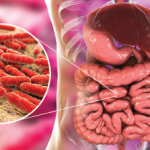NEW YORK (Reuters Health)—An adherent-invasive E. coli pathotype present in the bowel may contribute to the development of Crohn’s disease-associated spondyloarthritis, researchers say.
“Clinical symptoms, including extra-intestinal manifestations, in Crohn’s disease offer a portal into the microbial, immune, and genetic mechanisms underlying disease pathogenesis,” Dr. Randy S. Longman from Weill Cornell Medical College in New York City tells Reuters Health.
“Our work highlights the potential role for host-microbe interactions that drive systemic inflammation in Crohn’s-associated peripheral spondyloarthritis,” he says.
Alterations in the intestinal microbiome seen in inflammatory bowel disease have suggested a role for the microbiome as a driver of systemic inflammation, Dr. Longman and colleagues note in Science Translational Medicine, online on Feb. 8. But the microbiome in Crohn’s disease-associated spondyloarthritis (SpA) has not been well characterized, they add.1
The team used a recently developed technique (IgA-seq), which couples the sorting of IgA-coated microbiota with 16S ribosomal RNA sequencing, to characterize the microbiome of 59 Crohn’s disease patients with and without SpA.
Although there were no significant differences in overall microbiome diversity between patients with and without SpA, there was a positive correlation between SpA and Proteobacteria and Enterobacteriaceae abundance.
IgA-seq revealed a significant enrichment of E. coli that were similar in genotype and phenotype to an adherent-invasive E. coli (AIEC) pathotype.
Although these AIEC did not induce overt intestinal disease in a mouse model, despite robust colonization, they were broadly adherent to the epithelial mucosa.
Intestinal colonization with these Crohn’s disease-SpA-derived AIEC promoted mucosal Th17 immunity, induced systemic Th17 immunity, and promoted joint inflammation.
“In addition, our study found the presence of a virulence gene called pduC in AIEC isolates from patients with CD-SpA,” Dr. Longman explains. “This gene allows these bacteria to forage for fucose metabolites abundant in the intestinal mucous layer and promote close association with the epithelial layer. When we genetically knock out this gene in one of our isolates, we prevent these bacteria from inducing Th17 cells. This exciting finding highlights a potential bacterial metabolic pathway that can be therapeutically targeted to alter Th17 induction.”
“Importantly, our work highlights the activation of the IL-23/Th17 pathway in patients with Crohn’s disease-associated peripheral spondyloarthritis,” he says. “With the recent approval of anti-IL-23 biologic therapy in Crohn’s disease, our findings may offer a guide for helping to select biologic therapy.”
Dr. Laurent Dubuquoy from Lille Inflammation Research International Center at Lille University in France, who studies chronic bowel inflammation and inflammatory joint disease, tells Reuters Health by email, “The pathogenic mechanisms induced by AIEC are far from clear despite the clear demonstration of its importance in [Crohn’s disease] pathophysiology.”
“The main message for physicians should be to focus less on microbiota changes but focus more on host response to this intestinal flora, at least in the context of inflammatory bowel diseases [IBD] and their extraintestinal complications,” Dr. Dubuquoy concludes. “This should help to choose more-targeted therapies.”
“Early detection of this immune response against AIEC appears an interesting marker to predict extraintestinal complication of [Crohn’s disease],” he adds. “This should allow the earlier use of targeted therapy and then increase its efficacy.”
Reference
- Viladomiu M, Kivolowitz C, Abdulhamid A, et al. IgA-coated E. coli enriched in Crohn’s disease spondyloarthritis promote TH17-dependent inflammation. Sci Transl Med. 2017 Feb 8;9(376). pii: eaaf9655. doi: 10.1126/scitranslmed.aaf9655.


